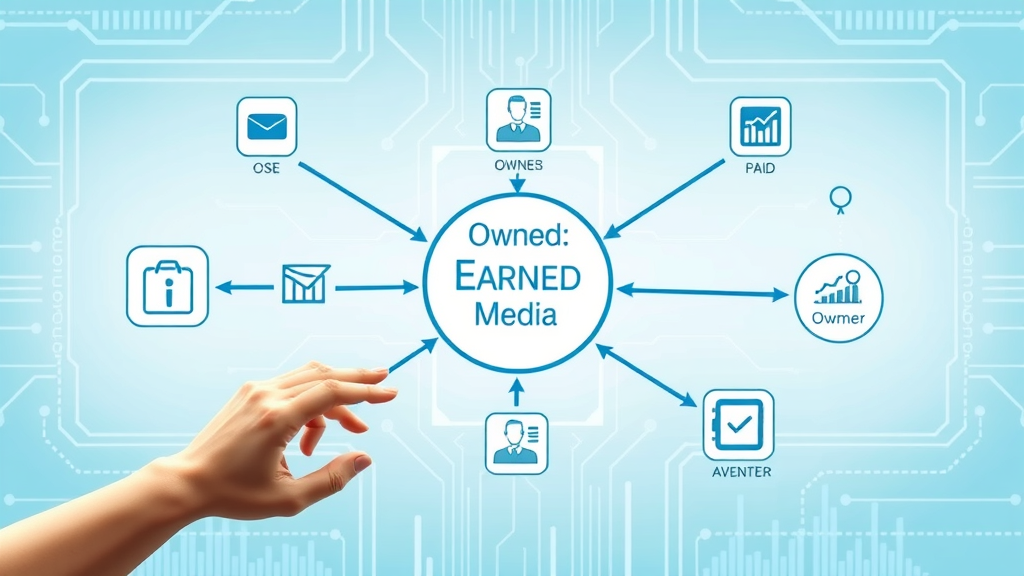- Did you know that over 60% of high-performing content fails to reach its target audience simply due to using the wrong content distribution channels? Discover why mastering these channels is the key to amplifying your brand’s voice and ROI.

How Content Distribution Channels Influence Your Reach: Essential Insights
- Defining content distribution channels and their role in your content marketing strategy
- Key distribution channel types: owned channels, earned channels, and paid channels
- How leveraging the right content distribution channel maximizes content performance
Content distribution channels are the lifelines of every successful content marketing effort. At their core, these channels are the pathways through which your valuable content journeys to reach its target audience . Whether you’re publishing a blog post, sharing a breakthrough on social media, or launching a newsletter, the platform you choose shapes how many people see and engage with what you create. Selecting the right distribution channel is not just a matter of preference—it’s a strategic decision that directly affects the reach, resonance, and ROI of your content initiatives.
There are three principal types of content distribution channels: owned channels (your website, blog, or email newsletter), earned channels (mentions by influencers, social shares, or guest postings), and paid channels (sponsored posts, social media ads, or content syndication platforms). By understanding the strengths and limits of each media channel , you can map your distribution strategy to introduce your content where your audience already spends time—and where it’s most likely to spark lasting engagement.
"Great content is wasted if it’s not distributed through the right channels to the right audience." – Industry Thought Leader

The Core Types of Content Distribution Channels Explained
To maximize your brand’s online visibility, it’s vital to understand each major content distribution channel and how it contributes to overall distribution strategy . Let’s break down the three fundamental groups—owned, earned, and paid channels—and see how each can lift your content marketing game.
Owned channels are platforms where you have direct control over publishing and audience engagement. These are the base from which you shape your brand voice and analytics strategy. Earned channels allow your content to travel organically—think word-of-mouth or influencer advocacy. Paid channels supercharge reach, ensuring even your best blog posts and webinars get the spotlight they deserve in crowded marketplaces. By strategically combining these types of content channels, you can achieve a systemic approach to maximize visibility, credibility, and conversions.
Owned Content Distribution Channels: Building Authority On Your Platforms
- Websites, blogs, email newsletters: foundational owned channels
- Benefits of direct control over content and audience data
Owned channels are the backbone of any robust content distribution strategy. Your website , corporate blog , and email newsletters are prime examples—platforms where you own the conversation, shape the brand narrative, and gather deep audience insights. Publishing a blog post on your company’s site not only showcases your expertise but also gives you control over content presentation and SEO, boosting your presence in search engines.
With email newsletters , you can nurture leads in a personalized way and track open rates, clicks, and conversions with great accuracy. These channels allow direct communication, enabling strong relationships with your target audience without interference from third-party algorithms. Not only do you retain full ownership of audience data, but you also minimize dependence on volatile algorithms that may change overnight, potentially derailing your reach or growth trajectory.

Earned Content Distribution Channels: Expanding Reach Organically
- Guest posting, social media shares, influencer mentions
- Strategies for maximizing earned channels impact
Earned channels comprise the opportunities you gain organically—such as guest postings, influencer mentions, and viral social media shares . These earned channels amplify brand awareness by letting third-parties vouch for your value. A guest blog post on an industry publication, for instance, positions your brand as an authority and often delivers targeted referral traffic.
To make the most of these distribution channels , focus on building genuine relationships with influencers and crafting share-worthy content that naturally attracts attention. Make it easy for others to distribute content by including shareable visuals, quotable soundbites, and strong calls to action. Since you don’t control these media channels , results can vary, but a strong earned strategy can catalyze exponential reach—and introduce your brand to fresh, engaged communities.

Paid Content Distribution Channels: Accelerate Growth with Precision
- Social media advertising, paid content distribution platforms, sponsored posts
- Cost-benefit analysis of paid distribution channels
Paid content distribution channels ensure your message isn’t left to chance. This includes social media advertising (like Facebook ads), paid syndication networks (Taboola, Outbrain), and sponsored posts. Paid content guarantees placement, and often provides advanced targeting tools so your content type is shown to the perfect audience—whether you’re highlighting an ebook or broadcasting a breakthrough product video.
While paid distribution channels require budget, their precision targeting and scalability often deliver measurable increases in traffic and conversions. The key is careful monitoring: leverage analytics to assess campaign effectiveness and return on investment. When combined with owned and earned strategies, paid content can quickly boost brand awareness, fill the top of your funnel, and amplify high-performing content across any relevant media platform.
Crafting a Content Distribution Strategy That Works
- Setting clear objectives for your content distribution strategy
- Identifying your target audience for effective distribution channels
- Choosing the right media platforms—social media, email newsletters, and more
Creating an effective content distribution strategy means more than selecting channels at random. Start by defining clear objectives: Are you seeking brand awareness , lead generation, or deeper audience engagement? Once your goals are in place, identify your target audience —consider their demographics, pain points, and where they spend their time online.
Next, select your media platforms wisely. For instance, professionals may respond better to LinkedIn articles, while lifestyle content can flourish on Instagram stories or YouTube. Map out your distribution channels in an editorial calendar, assign content types to best-fit channels, and ensure consistent, audience-aligned messaging across every media post or update. This thoughtful process helps you deliver the right message, to the right people, on the right platform, at the right time.

Aligning Content Types to Distribution Channels for Maximum Impact
| Content Type | Optimal Content Distribution Channel |
|---|---|
| Blog Posts | Company website, LinkedIn, Twitter, Facebook |
| Whitepapers & Ebooks | Email newsletters, LinkedIn groups, Paid syndication |
| Videos (How-tos, Explainers) | YouTube, Facebook, Instagram Stories |
| Podcasts | Podcast directories, Company blog, Social media |
| Infographics | Pinterest, Twitter, Industry publications |

Top Content Distribution Channels Every Marketer Should Leverage in 2024
- Overview of leading content distribution channels: Facebook, Instagram, LinkedIn, Twitter, YouTube
- Assessing newer media channels and emerging platforms
As digital behavior shifts, so do the leading content distribution channels . In 2024, giants such as Facebook , Instagram , LinkedIn , Twitter , and YouTube remain essential. Each offers unique advantages for distributing blog posts, product launches, or social media content to expansive and highly engaged audiences. Facebook and Instagram are perfect for visual storytelling and quick audience feedback, while LinkedIn shines for B2B thought leadership and detailed media posts .
Don't sleep on emerging platforms—newer media channels like TikTok, Clubhouse, or Threads present opportunities to reach younger, trend-driven communities. Align each channel with your content type and experiment with small tests before scaling efforts. By continuously evaluating where your target audience is most active, you ensure your distribution channel mix keeps pace with changing online behavior.

List of Essential Distribution Channels for Modern Marketers
- Company website
- Corporate blog
- LinkedIn publishing
- YouTube channel
- Instagram stories
- Email newsletters
- Podcast directories
- Industry-specific earned channels
- Paid syndication networks (e.g., Taboola, Outbrain)
These essential distribution channels form the toolkit for modern marketers aiming for diverse reach. Each distribution channel unlocks unique opportunities—from nurturing loyal community members on your company blog to engaging wide audiences through paid content distribution.
Incorporate each channel as part of a balanced content distribution strategy . Test new platforms regularly, track outcomes, and optimize for the best-performing media platforms relevant to your brand and audience.
Case Study: How a Distribution Strategy Multiplied Reach for a SaaS Brand
- Real-world example highlighting successful use of content distribution channel selection and results driven
A fast-growing SaaS brand wanted to amplify a new feature launch. Instead of solely relying on owned channels, they mapped out a strategy that used a dynamic mix: a feature-deep blog post published on the company website, exclusive insights sent to their email newsletter list, and short explainer clips posted across LinkedIn and Twitter. They also partnered with micro-influencers for earned channels , while running targeted paid campaigns on LinkedIn and Outbrain.
Results were dramatic: the blog post generated a 300% traffic increase over average, and influencer shares produced new leads from untapped market segments. Paid channels amplified the best-performing posts, accelerating signups during the launch week. This case highlights the importance of an integrated, multi-channel distribution strategy —and how matching the right content type with the appropriate distribution channel multiplies impact.

Selecting Distribution Channels Based on Target Audience and Content Goals
- Mapping target audience demographics to preferred media platforms
- Matching types of content to relevant distribution channel for greater engagement
Every successful content distribution strategy starts with your target audience . Analyze their demographics, behaviors, and the media platforms they trust. For example, if your audience is Millennials interested in lifestyle, Instagram and TikTok are likely the most effective distribution channels . B2B buyers, contrarily, might prefer LinkedIn, specialized forums, or email newsletters.
Align your type of content with the most relevant platform to improve both reach and engagement. For actionable insights, use audience analytics, social listening tools, or surveys to pinpoint where and how your market consumes content. Personalize your content creation tactics to fit each channel’s strengths, and stay flexible as preferences evolve.
Optimizing Content for Multiple Content Distribution Channels
- Tips for repurposing content across distribution channels
- SEO, visuals, platform-specific tweaks for improved performance
To unlock the full value of your content distribution channels , avoid a copy-paste approach. Repurpose long-form blog posts into infographics, social media snippets, or short-form videos suitable for each platform. Optimize for SEO by using relevant keywords and crafting platform-friendly headlines. Adapt visuals for each channel: vertical for Instagram Stories, landscape for Twitter and LinkedIn.
Fine-tune messaging to reflect each platform’s user expectations—what works for your email newsletter may need a creative twist for social media. Schedule content with editorial calendar tools to maintain consistency, and use A/B testing to discover which formats or messages perform best on each media channel .
Tools and Technologies Powering Content Distribution Channels
- Must-have platforms: editorial calendar tools, analytics, social scheduling
Harness the latest tools to streamline your content marketing workflow. Editorial calendar platforms like Trello or Asana help organize content creation and scheduling across all distribution channels . Analytics tools (such as Google Analytics and Sprout Social) let you track engagement and performance, while social media schedulers (like Buffer, Hootsuite, or Later) ensure your posts hit optimal publish times.
Integrating these tools gives you actionable insights into which channels and types of content generate the most engagement. Automate repetitive tasks so your marketing team can focus on strategy, testing, and creative development for each media platform .

"Distribution is no longer about volume—it’s about precision and timing across channels." – Marketing Innovator
Measuring Success Across Your Content Distribution Channels
- Key distribution channel metrics: reach, engagement, conversions
- Using analytics to refine your distribution strategy
Effective use of content distribution channels is measurable. Track key metrics—reach (total audience), engagement (likes, comments, shares), and conversions (signups, downloads, sales)—to evaluate which media channel pays off best. Dive into analytics tools to reveal trends, uncover top-performing content, and spot optimization opportunities for each distribution channel .
Continuous measurement allows for agile improvements. Adjust your content distribution strategy by doubling down on what works and refining or replacing underperforming efforts. As audiences and platforms evolve, data-driven decisions keep your strategies ahead of the curve.

Common Pitfalls to Avoid with Content Distribution Channels
- Over-reliance on one distribution channel
- Ignoring earned or paid content opportunities
- Mismatched content and distribution channels
Over-dependency on a single distribution channel leaves your brand vulnerable to algorithm changes or platform disruptions. Diversify efforts across owned channels , earned channels , and paid platforms for a robust safety net. Don’t ignore earned channel opportunities—third-party advocacy can be more credible than direct marketing.
Mismatching your content type with the wrong platform often results in low engagement. Take time to understand what content formats succeed where, and tailor your approach for each audience segment. By continually evaluating your mix, you minimize wasted effort and maximize the ROI of both your content and distribution spend.
People Also Ask
What is a content distribution channel?
- A content distribution channel is any platform or medium used to share, promote, or distribute content to a targeted audience. Examples include owned platforms like websites and blogs, earned placements via guest posts, and paid media such as social ads.
What are the 4 distribution channels?
- The four main distribution channels are direct (owned), indirect (earned), paid, and hybrid models. Each complements a robust content distribution strategy when aligned with content and audience goals.
What are the three 3 platform categories for content distribution?
- Content distribution typically falls into three categories: owned channels (your platforms), earned channels (third-party mentions, shares), and paid channels (advertising, sponsored content).
What is an example of a content distribution strategy?
- A SaaS company creates a blog post promoting a new feature, sends it to their newsletter (owned), shares it on LinkedIn and Facebook (owned/earned), secures influencer shares (earned), and supports it with sponsored LinkedIn ads (paid).
Frequently Asked Questions
- How do I choose the right content distribution channel for my business? Consider your audience demographics and content goals. Research where similar content performs best and test a blend of owned, earned, and paid channels, optimizing based on results.
- Should every piece of content be shared across all channels? No, tailor content to fit the platform’s audience and format. Quality engagement comes from delivering the right content in the right context.
- What’s the most effective paid channel for B2B content marketing? LinkedIn remains the top choice for B2B, offering precise targeting and professional reach. Pair it with other channels for maximum strategic coverage.
Actionable Tips to Elevate Your Content Distribution Strategy Today
- Audit current content distribution channel performance
- Experiment with new distribution channels quarterly
- Segment content for different distribution channel audiences
- Automate and schedule for consistent delivery
Routine auditing, experimentation, and segmentation can transform your content distribution strategy from static to standout. Prioritize scheduling and automation to ensure all audiences receive timely, relevant updates.

Master Content Distribution Channels for Lasting Success
- Achieving elevated reach means strategically leveraging the right content distribution channels for your unique brand, audience, and goals. Begin planning your comprehensive content distribution strategy now to outperform a crowded market.
Start your multi-channel strategy today to ensure your brand content never goes unseen—your audience is waiting!
To further enhance your understanding of content distribution channels, consider exploring the following resources:
This article provides a comprehensive overview of content distribution, detailing the three main types of channels—owned, earned, and paid—and offering practical tips for effectively promoting and sharing content across various platforms.
This resource delves into the mechanics of content distribution, explaining how to leverage owned, earned, and paid channels to maximize content reach and engagement.
By reviewing these articles, you’ll gain valuable insights into developing a robust content distribution strategy that aligns with your marketing objectives.
 Add Row
Add Row  Add
Add 




Write A Comment